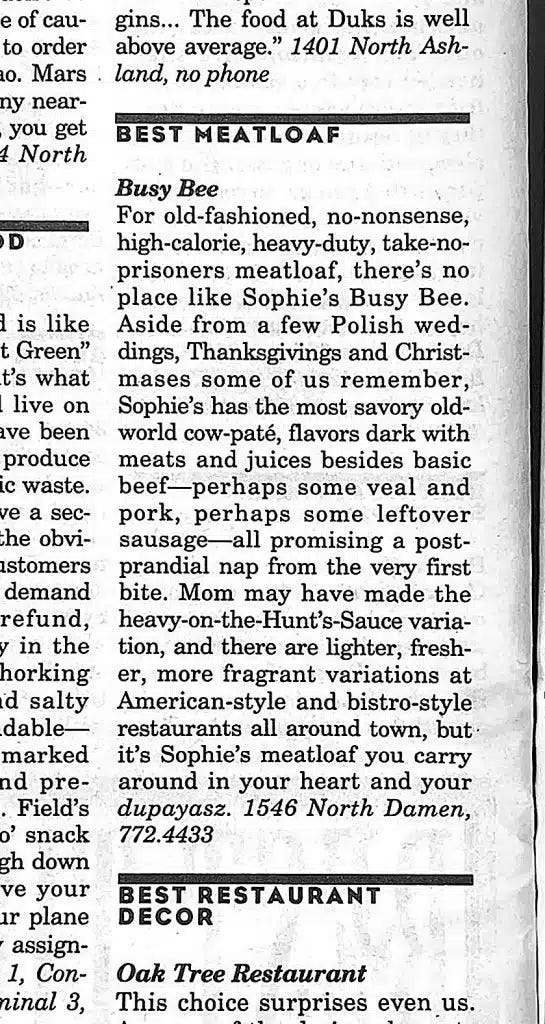Chris Ware, “Best Of Chicago,” 1993
In its February issue, Newcity has published its thirtieth and final edition of “Best Of Chicago.” December 2022 saw the return of the Film 50 Chicago film industry survey, which I write and edit after conducting a raft of interviews.
A link to this year’s Best of Chicago’s 183 items, by a flock of writers including Ted C. Fishman, David Hammond, Sharon Hoyer, Scoop Jackson, Vasia Rigou, Mary Wisniewski, David Witter, Alison Cuddy, Dave Hoekstra, Dennis Polkow, Robert Rodi, Frank Sennett and Sara Stern, is here.
Sampling my contributions:
Mike Royko
You try writing that many words that many times a week for that many years and creating literature: an old-fashioned, twentieth-century metro columnist could smoke a pack and down the pints, but the tap-tap-tap-DING! of the typewriter and its carriage was siren song and tolling bell. The greatest of them all may have been Jimmy Breslin, who specialized in turning momentous world events and tiny moments into rhythmic literature, but our very own Mike Royko is no slouch: while some of the character comedy of figures like Slats Grobnik might not sound the notes today, the daily evocation of the man-on-the-street, working-class, from the neighborhoods, was an unparalleled feat. Literature was not the game or the goal; it’s like his longtime Sun-Times compatriot columnist Roger Ebert put it, you’re striking up a conversation, one you’ve been in the middle of for all the time your reader has read you in real time. But Royko also crafted one of the greatest masterpieces of Chicago portraiture, a great and lyrical and unsentimental small slab called “Boss.” (Breslin called it “The best book written about an American city, by the best journalist of his time.”) Everything seen and learned and inscribed from decades of columnizing is poured into the 200-plus pages of “Boss: Richard J. Daley of Chicago.” “The workday begins early,” it begins. As in newspapering, so it went in machine politics.
From 1997, from a lost stretch of Chicago Avenue near the alt-weekly then-offices:
Publican Quality Bread
Chicago’s upper crust, without a doubt: Publican Quality Bread, now with a storefront open to the public on Grand, functioning as bakery and wholesaler, is like each permutation of the One Off Hospitality approach since the group’s founding: it’s not just in it for the dough, but whoa! This is the high level of culinary attainment, modestly scaled yet magnificently flavored, that ought to be recognized and sustained as rare and special, as it builds on the instinct and talent of its creators and makers. Restaurants can fill their tables with delicious foodstuffs, but regular Chicagoans can stuff their faces as well. It’s emblematic of the hand-fashioned impact of One Off, from Blackbird and Avec and Publican and Big Star and on and on forward: think and plan and hope for years, learn, yearn, season to taste, build from within, empower talent, bake, serve. 1759 W. Grand, publicanqualitybread.com
A 1993 contribution (unsigned), about a long-lost outpost of Polish Chicago in Wicker Park that nestled under the fuss and bustle of the El:
The Rainbo Club
It’s a box. The box 1990s Chicago came in, an eighty-six-year-old container that has not changed notably since its fall 1985 purchase by investors, including owner Dee Taira. It’s a squat box that was built around 1936, a veritable panopticon in which to watch and be watched, with no hiding place except the crotchety photo booth. It’s a timeless Chicago dive, dragging the history of every regular patron past and future with it. With the acceleration of gentrification in the Greater Liquor Park zone—Wicker Park, Ukrainian Village—a generation or three of older customers have been priced out of the ambit of daily pilgrimages, but it doesn’t stem ritual sojourns for cheap drinks and major meet-ups.
1150 N. Damen
A fervent introduction has kicked off each of a decade’s worth of Film 50 compilations in Newcity. Here’s the 2022 edition.
Annnnd… action!
So many scenes! Behind the scenes of what constitutes “film”—industry and community, in Chicago and the Midwest—is circle upon circle, an ecstasy of Venn diagrams, a steady pulse of rings shaped by raindrops touching the surface of the bodies of water (and humanity) that bound and bind us, shapes that eddy outward, and overlap, and refresh this great lake of effort, inspiration and talent.
Within these fifty entries, whittled down from several hundred possibilities, comprising seventy-plus players in the Midwest who work in film, these gifted people are their own Venn diagram, participating in more circles than you would ever expect, if you were unfamiliar with the wondrous industry of Chicago film workers. The multiplicity is prodigious: producers etching infrastructure; programmers shaping history by presenting vital work; exhibitors keeping the movie theater experience alive; archivists restoring and refreshing history; the media that alerts us to nightly apparitions of the art form; a wealth of changemakers setting collaborations and looking outward to a larger world.
While these conversations are slightly larger than sound bites, these words are only glimpses of the activities of each person or group. I suggested that what they should share would be like text messages to their circle and the world beyond: casual, intuitive, sincere. We don’t talk much biography—where they were—but instead about instincts and inspirations for sustaining and building and even redefining what audiovisual storytelling is, and can be—where we are going—in the modern moment, in the Chicago that is surely to come.
What comes after that, in 27,000 of their own words, are profiles of fifty key leaders behind the scenes in Chicago film.
The complete 2022 FILM 50 is here.
Buy a print edition here. (Shorter entries, but with Sally Blood’s portraits, shot at the Music Box Theatre.)
And an extended interview: Why Chicago's Music Box Theatre and Music Box Films are unique: a 7,000-word Q&A with key players Bill Schopf, Brian Andreotti, Ryan Oestreich and Lisa Holmes.






